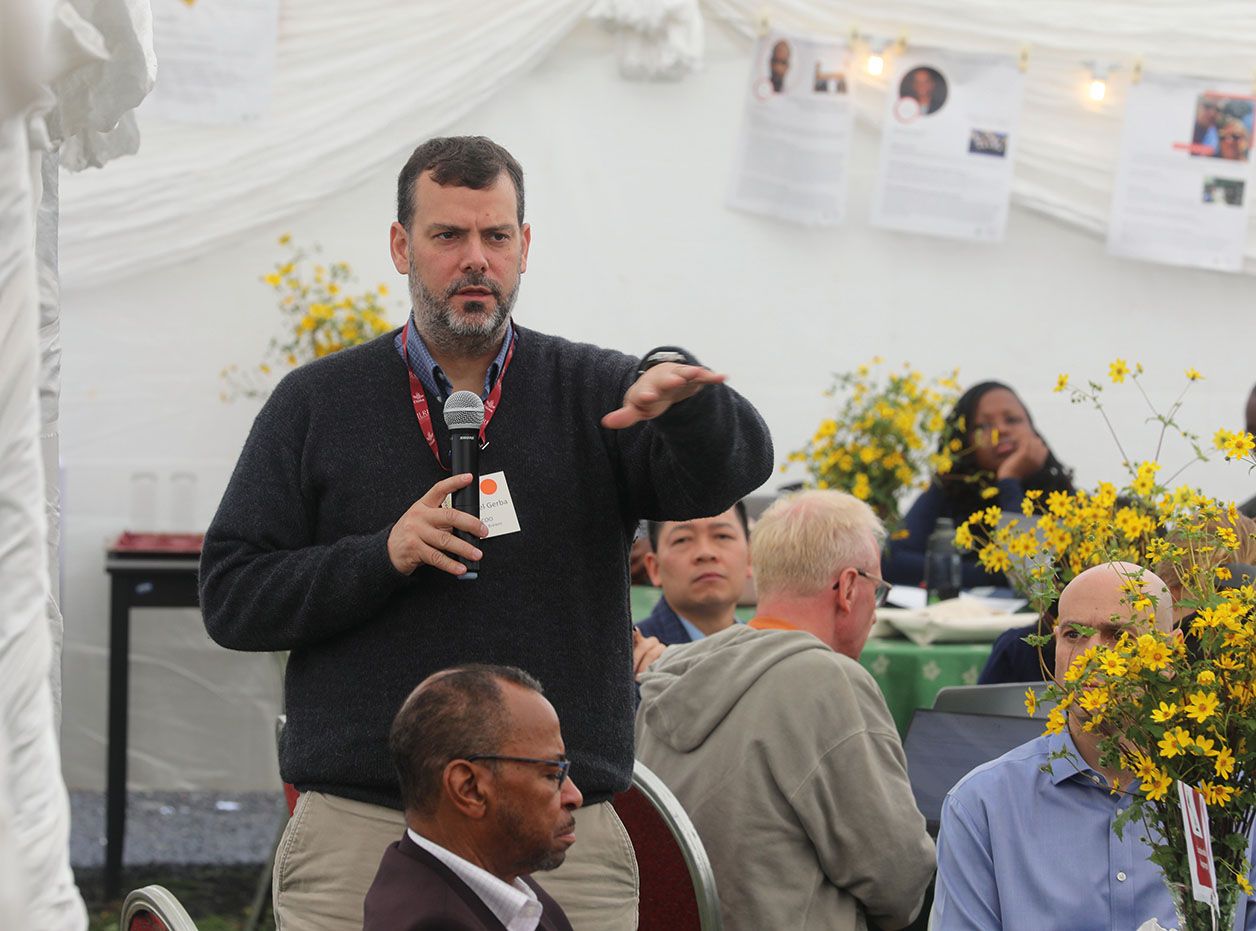Breaking down barriers

John E. Kaye
- Published
- Executive Education, Home

Tackling unconscious bias as a leader takes honesty and openness – and your organisation will be better for it, writes Yetunde Hofmann
Unconscious bias training has come under much criticism of late because of the lack of traction and change it effects in organisations, as illustrated in McKinsey’s ‘Women in the Workplace 2020’ report.
Yet, understanding your own unconscious and conscious biases as a leader, and choosing to do something about it, makes a material difference. It is one of the ways in which you can ensure the success of your organisation’s inclusion agenda.
Throughout this article I highlight some of the ways you can tackle unconscious bias effectively.
Decide that you want to do it
In the context of inclusion, commitment is a leadership attribute that is mentioned and lauded more than it is actually demonstrated. A key condition to successfully tackling unconscious bias is that, as a leader, you reflect on why you want to tackle it, the benefit it will bring to you, your colleagues and your organisation and the consequences of not doing so. What’s in it for you? Only when you’ve made the genuine decision should you move forward with doing something about it.
Be clear on your “why”
When you are in leadership, everyone in your organisation – from your own boss right down to the people on the front line of your organisation – are watching your every step. The higher you are on the organisation ladder, the louder your quietest whisper will be heard through the organisation. The “what” and “how” of your behaviour will influence the “what” and “how” of your followers’ behaviour, so being clear on your why, both personally and for the organisation, and communicating this will support the change you want to bring about as a result of addressing your own unconscious bias.
Raise your individual awareness of what your biases are
It is important to know what it is you want to address when it comes to your biases. Every human being has biases and that is not a bad thing in itself. The problem emerges when the bias works to the exclusion of another person unfairly. Start with educating yourself on what unconscious bias is, how it shows up in relation to other people and then assess yourself to see which biases are most likely to be associated with you. You can take tests like the Harvard Implicit Association Test to inform yourself and identify your blind spots and the areas of your behaviour that you can change. If you lead a team, encourage the team to do the same and discuss your findings together. What will you do about it and how will you hold each other accountable in following through on your commitments?
Listen without defence
Spending quality time with the members of the underrepresented groups in your organisation and listening to their stories and examples of how your behaviour as a leader and that of other leaders has impacted them negatively is critical. Doing this will give you the opportunity to deepen your learning and understanding of the messages you send to key talent in your business unknowingly. Listening without defence is key – you need to be open to what you hear. Asking the question, “What can I do differently?” will elicit ideas on the impactful actions that you can take to bring about change in the short- and long-term. Asking the question and doing nothing about it will only challenge your integrity and send a message that you don’t care. This will ultimately lead to the unsuccessful implementation of any work you do to address unconscious bias.
Conduct a review of your team and/or organisation’s practices
Your people processes – from the point of attraction, recruitment and selection, all the way through to performance assessments and promotion criteria, to terms and conditions of exit and change – are the places where people will experience your unconscious bias most strongly. Conduct a root and branch review of all of them. Engage the support of your people function and also members of the underrepresented groups and ethnicities fully. Make radical changes where needed. Check your own behaviours. Who do you nominate most for those high profile projects when you’re asked? Who do you invite to join you and your team in the strategy review meetings and why? Who do you back the most when asked to nominate talent for those high profile in-house leadership development programmes? Who do you sponsor to attend external leadership programmes that would be of benefit to them as individuals?
Take proactive action – become an ally
It is one thing to speak up for yourself. It is another to have someone walk beside you and speak up for you. Being an ally means you, as a white male or female, calling out behaviour that you know may lead to the exclusion, unfair treatment or disadvantage of another person from an underrepresented group. It means proactively asking what the impact of your decisions will be on every person and represented group in your organisation. As a team leader, it means challenging your team members to do the same. It also means that when someone from a minority group joins your team, you proactively welcome them and ensure that their needs are met. This is good leadership, regardless of who the new member is. When someone who is different comes into your team, it is especially great leadership to do this, as it demonstrates your empathy and inclusiveness.
If you’re a senior leader, proactively choose to sponsor the career development and advancement of members of the most underrepresented groups in your organisation. Back them for promotion and commit to taking personal responsibility for their success in a project or more senior role. Invest in their development and their ability to build a strong network with people whose personal and professional experiences they can more easily relate to.
Mentor someone different to you
Understanding your unconscious biases and taking immediate action to address them is one thing. New behaviour is, however, soon forgotten in the melee of day-to-day work activity – the pressures of which are immense. This is one of the reasons why unconscious bias training sometimes fails. The recipients of the training return to their old behaviours! When, as a leader, you choose to invest your time mentoring someone different to you, it gives you a deeper level of understanding of who they are, their hopes and aspirations as well as their gifts and talent. It enables you to contribute to the leadership development of another person whilst developing your own leadership. This is a win-win as mentoring is also said to help leaders relieve stress.
Tackling unconscious bias as a leader, like anything worth doing, is worth doing well. It, however, takes a multi-pronged approach. It takes a willingness to be vulnerable and open in your self-assessment before committing to doing something effective to make a lasting change.
About the author
 Yetunde Hofmann is a board-level executive leadership coach, mentor, and an inclusion & diversity expert.
Yetunde Hofmann is a board-level executive leadership coach, mentor, and an inclusion & diversity expert.
She is the author of ‘Beyond Engagement’ and founder of SOLARIS – a pioneering new leadership development programme for black women. Find out more at: www.solarisleadership.com
Sign up to The European Newsletter
RECENT ARTICLES
-
 ETH Zurich and the University of St.Gallen redefine executive education with emba X, a new model of responsible leadership
ETH Zurich and the University of St.Gallen redefine executive education with emba X, a new model of responsible leadership -
 Why leadership is the strongest defence in South Africa’s schools
Why leadership is the strongest defence in South Africa’s schools -
 Porto Business School launches executive programme on AI strategy
Porto Business School launches executive programme on AI strategy -
 POLIMI Graduate School of Management strengthens global reputation in MBA and master’s rankings
POLIMI Graduate School of Management strengthens global reputation in MBA and master’s rankings -
 Trinity Business School strengthens standing in global MBA rankings
Trinity Business School strengthens standing in global MBA rankings -
 Meet the class of 2025… and their children. Why mid-life university learning is on the rise
Meet the class of 2025… and their children. Why mid-life university learning is on the rise -
 University of Michigan launches executive programme for chief data and AI officers
University of Michigan launches executive programme for chief data and AI officers -
 International education: A vision for global citizens
International education: A vision for global citizens -
 How to create lasting social change? Build a community
How to create lasting social change? Build a community -
 Tomorrow’s world needs Dyslexic Thinking
Tomorrow’s world needs Dyslexic Thinking -
 Why family therapy is the best investment you can ever make
Why family therapy is the best investment you can ever make -
 How EQ can give us the edge over AI
How EQ can give us the edge over AI -
 A true root and branch approach
A true root and branch approach -
 It's fine to say you're not ok
It's fine to say you're not ok -
 Are you willing to change with your organisation?
Are you willing to change with your organisation? -
 Emerging markets: Online learning for women unlocks economic potential
Emerging markets: Online learning for women unlocks economic potential -
 A programme of urgent importance
A programme of urgent importance -
 Why progress is not parity
Why progress is not parity -
 Begin by building trust
Begin by building trust -
 Have we the energy for cryptocurrencies?
Have we the energy for cryptocurrencies? -
 Make your employees everyday data scientists
Make your employees everyday data scientists -
 The power of understanding
The power of understanding -
 Welcome to the team
Welcome to the team -
 Become your best self with Gies
Become your best self with Gies -
 The benefits of seeing the bigger picture
The benefits of seeing the bigger picture



























